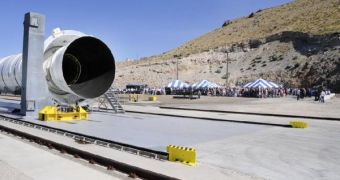As we were reporting yesterday, NASA and ATK Space Systems, a division of the Brigham City, Utah-based Alliant Techsystems, attempted to test-fire the newly finished ARES I rocket motor for the first time. However, a minor glitch caused the test to be postponed until Tuesday, officials at the space agency and the contractor said in a statement. Engineers believe that the source of the malfunction may have been a fuel valve in an auxiliary power unit, but they are currently unsure as to exactly why the glitch occurred, Space reports.
“This is part of what you do when we do tests, this is part of the job,” the NASA Ares Projects Office First Stage Manager, Alex Priskos, says of the failed test. The first-stage development motor, or DM-1, is managed by the Ares Projects division, located at the NASA Marshall Space Flight Center, in Huntsville, Alabama. The broken valve powers the motor's booster nozzle hydraulics and is essential to the correct progression of the test fire. The rocket is still secured at ATK's Utah test facility.
The failure disappointed thousands of spectators, who came to the firing range to witness history in the making. The firing of DM-1 was to represent the first live glimpse of Project Constellation for the general public, other than high-tech computer graphics and artists' concepts. The motor is to power the smallest of the Project's delivery systems, but its correct functioning also has implications for the larger rockets, the ARES IV and ARES V heavy-lift systems. The role of ARES I in NASA's future plans is to carry the Orion Crew Exploration Vehicle to low-Earth orbit, and eventually to the Moon.
The massive, five-segment first stage of the rocket is 154 feet (47 meters) long, and is capable of generating a maximum of 3.6 million pounds of thrust, which is about 24 percent more power than that of one twin Shuttle solid rocket booster. It is also taller and thinner than the regular shuttle and its attached external fuel tanks, which is why the Launch Pad 39B facility at the Kennedy Space Center, in Cape Canaveral, Florida, has been reassigned from the Shuttle Program to the Project. Preparations are underway at the pad, which engineers hope will be able to accommodate the new rocket by the end of this year.
A successful ARES I test would assure critics that Project Constellation is on the right track, and that the 2015 deadline for its maiden flight could be respected. However, there is still much work to be done by then, especially on Orion and on ARES V. Controversies are now raging on as to whether this is the best course of action for the agency to take.

 14 DAY TRIAL //
14 DAY TRIAL //